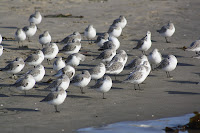However I was more interested in the beach itself, and its neighbour Marina Del Rey. The Sanderling is one of those 'big' birds (Others being Peregrine, Osprey etc.) that has been common in each country I've lived in, but I've still yet to come across.
Venice beach matched the description of this bird's winter habitat perfectly, and I was literally told that all I would have to do is find some waves anywhere down the coast and the birds would be there. Since I had spent a lot of effort trying to locate them in the past I was a bit skeptical.
The gulls around the place were fairly typical, but I surprised to find that the inland prairie California Gull actually outnumbered the typical Western Gulls in some areas. The very pretty Heerman's was also in great abundance here, too.
Apart from the typical gulls was a 2cy Ring-billed Gull (see left), which undoubtedly marks the start of the winter gulls arrival in California(the others being Glaucous-winged, Thayer's, Mew etc.) which I'll be careful to keep an eye out for in future. Of course it isn't as simple as that. Each gull has 3 plumages (1cy- Juvenile, 2cy- Immature and 3cy- Adult) and there are those intermediate plumages inbetween when they are in mid-moult. With hundreds of gulls spiralling over your head, having to check through each one thoroughly is frustrating at the least. And there is no guarantee I won't mix up a 2cy Glaucous-winged with a 2cy Ring-billed or Western. In the air they all look so similar.... Of course there are people out there who could give them a second look and tell you what they are, but I am not one of them!
Almost immediately on seeing the beach I caught sight of a flock of minute little shorebirds coursing around the coastline. Oh, I wonder what they could possibly be?
Eventually they all settled (a flock of about 40 birds) and offered some brief looks before trailling off again. I wasn't really expecting to see many, because on most occasions they stride around in flocks of less than 10.
It was at that point I turned around and found a flock of at least 100 (not all in the picture below) sitting right behind me within just a few metres. I guess they really were everywhere.
The birds were very photogenic (is that a word?), at least if you stood still. If I tried to approach them they would scatter before I could get too close but if I stood still the birds, in their foraging, would step closer and closer.
They had much more of a charm than their other Calidris sandpiper cousins, and maybe it was because they were so afraid of getting wet. They would let the waves come within inches of their feet, but any closer and they would bolt towards shore until the waves went back out to see. It only took one bird at the front to get too close to a wave, and immediately they were all darting away from the intruding sea in unison, cheeping in alarm. If only I had some way of filming. I've yet to find a video on the internet that portrays them correctly.
Funny little birds.
And yes, I did check the flock very thoroughly. As you may know shorebirds, like warblers, are very sociable and any strays will almost certainly socialize with the locals. But I saw nothing. At least until I looked through the pictures. If you look carefully on the left side (closer to the middle in the second) of these images there is a smaller, darker brown bird.
It's another Calidris sandpiper, but a different one, and its a Western Sandpiper. Before the Sanderling I have only seen one other Calidris, which was also a Western Sand. Unfortunately out of all the Calidris sandpipers that can turn up in California, it has to be that same one!











No comments:
Post a Comment